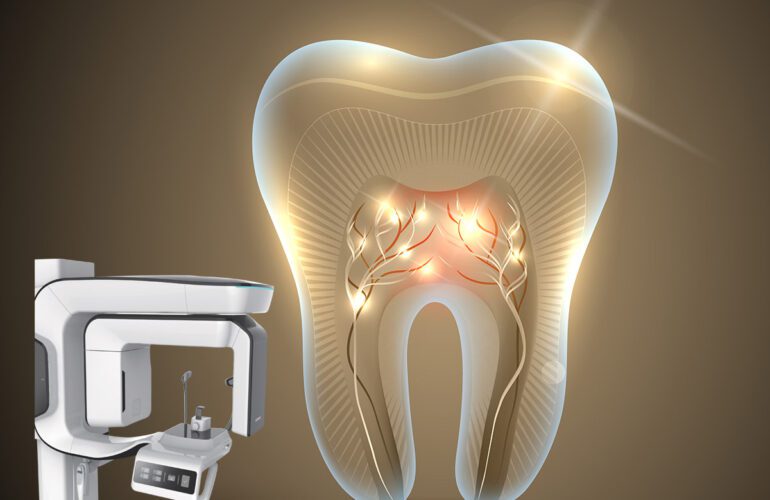Implantology
Tooth loss caused by periodontal disease, trauma or tooth decay can affect your smile. Dental implants are the best option if you are missing one or more teeth. Therapy with implants is a long-term solution. The advantage of implants is that they allow you to have a beautiful and functional smile without the need to grind your teeth, unlike fixed prosthetics (bridges) where your adjacent teeth are ground to replace the missing tooth.
What are implants?
Implants are titanium screws that resemble the root of a natural tooth and are intended to replace the same root. During the healing process, a solid bond is formed between the implant and the bone. Since the implants are made of biocompatible materials, the body does not recognize them as a foreign body and rejection does not occur.
Description of the Intervention:
Implant placement is a painless procedure under local anesthesia. Implants are installed using a surgical method. What to expect after the intervention:
After the anesthesia wears off, you may feel slight discomfort for a few days. Postoperative swelling may occur in some patients. All patients receive postoperative instructions and medications (analgesics and antibiotics). The feedback we received from a large number of patients is that analgesics (pain relievers) are either unnecessary (no significant pain) or only necessary for the first 24 hours after the intervention, after which the discomfort becomes less and less.
What is the procedure from the installation of the implant to the crown on the implant?
After the surgical installation of the implant, it is necessary to wait 3 months for the osseointegration process to be completed. After 3 months, gingivoformers are placed in order to shape the gingiva around the implant. After 2-3 weeks from the placement of the gingivoformer, the prosthetic phase can be started. An impression is taken on the implants and sent to the laboratory. Crowns on implants are made in the laboratory according to the impression. The final prosthetic work consists of an abutment and a crown. Before placement, the dentist will check whether the prepared crown matches the color and shape. After checking, it is permanently cemented or screw retained, and then the edges of the crown are additionally polished, which creates an invisible connection with the tooth.
Mobile prosthetics
In case of loss of a large number of teeth, when it is not possible to perform fixed prosthetic work, there is a possibility of rehabilitation with mobile or combined work.
Total dentures
They consist of a body and artificial teeth made of acrylate. The body of the prosthesis covers the palate in the case of the upper prosthesis and the ridge in the case of the lower prosthesis.
Partial dentures
They are made when there are a certain number of teeth on which the prosthesis would be attached. Chewing pressure is transmitted partly through these teeth, partly through the mucous membrane. The connection can be made with hooks (ready-made or cast) or clips (anchors), and the body can be made of acrylate or alloy (reduced) when we talk about vizil or wironit prostheses.
When is it necessary to install both gum and bone during implant installation?
In the past, it was considered a success when the implants osseointegrate. No special attention was paid to esthetics. Only the function was important. However, today it is expected that the crown on the implant not only has the function of a natural tooth, but also looks like a natural tooth symmetrical with such a tooth on the other side (e.g. the upper left implant crown of lateral incisor should look identical to the natural tooth of the upper right lateral incisor) . This aesthetic effect can only be achieved if adequate preparation has been done before or during the installation of the implant. Adequate preparation refers to building up bone and gums where necessary, in any case in the aesthetic zone (front teeth in the upper jaw). Otherwise, unaesthetic restorations can be obtained (asymmetric crowns on implants, one side longer than the other, etc.)
Types of prosthetic work (dental extensions to implants):
One tooth:
The installation of the implant is planned based on the clinical examination. After the healing process, which lasts from 3 to 6 months, an impression is taken on the implant. In the technical laboratory, a crown is made on the implant based on the impression.
Smaller bridge on implants:
In patients who are missing 3 teeth, 2 implants can be installed as a support. After the healing process, an impression is taken on the implants. Based on the impression, a bridge on implants is made in the laboratory. It can be cemented or screwed.
Bridge on 6 or 8 implants:
In patients who are missing all the teeth, rehabilitation of the complete jaw can be achieved with 6 implants in the lower jaw. In the upper jaw, it is sometimes necessary to plan 8 implants, although usually 6 implants are enough. With this treatment, after the implant healing process, the patient receives a fixed bridge (porcelain) that is either cemented or screwed. Prostheses on implants:
The number and position of the implants depends on the level of the bone. Most often, 4 implants are placed in the upper jaw and 2 implants in the lower jaw. A prosthesis is fixed to the implants.


